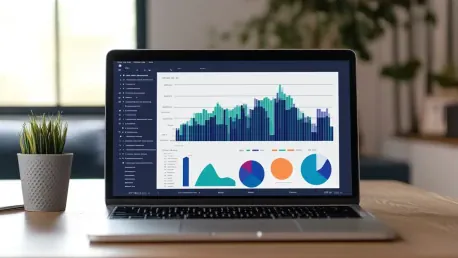The financial technology sector, or fintech, has rapidly restructured the fabric of financial services, affecting both businesses and consumers. Central to this evolution is data—specifically, how fintech companies collect, analyze, and transform data into actionable insights. Understanding the significance of fintech data analysis and its role in driving innovation can provide a clearer picture of the future trajectory of financial services. This article explores the various dimensions and techniques of fintech data analysis, the tools employed, the challenges faced, and the future prospects.
Understanding the Different Types of Fintech Data
Transaction Data
Financial transactions generate vast amounts of data every second. This includes payments, deposits, withdrawals, and loan requests. By meticulously analyzing transaction data, fintech companies can identify liquidity trends, detect fraudulent activities, and understand customer spending behaviors.
For instance, algorithms can track and flag unusual transactions in real-time, enhancing fraud prevention. Additionally, transaction patterns can reveal valuable insights into customer preferences, enabling personalized financial services and promotions. Understanding these patterns allows fintech firms to identify opportunities for creating more tailored financial products, thus enhancing the user experience and increasing customer loyalty.
The sheer volume of transaction data processed daily also presents a significant opportunity for predictive analytics. By leveraging historical data, fintech companies can forecast future trends, such as predicting which customers might apply for credit or which accounts are at risk of default. This preemptive approach allows financial institutions to devise tailored strategies to mitigate risk and optimize customer engagement.
Customer Behavioral Data
Customer interactions with fintech platforms provide a wealth of behavioral data that can be harnessed to improve services. This data encompasses user preferences, feature usage, and overall engagement. Behavioral insights help fintech firms tailor their offerings to meet specific needs, improving user experiences and increasing customer retention.
Analyzing customer behavioral data can also reveal usage trends, such as peak app usage times or popular features. Understanding these trends allows fintech companies to allocate resources more efficiently and develop features that align with user expectations. For example, if data shows a spike in mobile app activity during weekends, a fintech company might focus on enhancing mobile features to ensure seamless performance during peak periods.
Moreover, machine learning algorithms can segment customers based on their behavior, allowing for more targeted marketing efforts. By understanding the distinct needs and preferences of various customer segments, fintech companies can create more personalized and effective marketing strategies, leading to higher conversion rates and better customer satisfaction.
Market Data
Market data, including real-time data on stock markets, forex, interest rates, and commodities, is essential for financial analysis. This external data helps fintech companies optimize investment strategies and manage risks effectively.
By integrating market data with internal transaction and behavioral data, fintech firms can offer more precise financial advice and nuanced product recommendations to their users. This integration is crucial for providing competitive and timely financial services. For example, real-time market data can enhance automated trading systems, enabling them to make more informed and profitable trading decisions.
Furthermore, the ability to analyze market data in conjunction with historical performance metrics allows fintech companies to develop sophisticated financial models. These models can predict market movements and help users make better-informed investment decisions. By doing so, fintech firms empower their customers with tools that improve their financial outcomes, thereby fostering trust and loyalty.
Risk-related Data
Risk-related data encompasses credit scores, loan repayment histories, and various economic indicators. By examining this data, fintech companies can anticipate potential loan defaulters or evaluate insurance claim risks. This proactive approach minimizes risk and enhances financial stability.
Moreover, advanced risk scoring models can be developed to provide more accurate predictions, helping companies to tailor interest rates or insurance premiums according to individual risk profiles. These models utilize machine learning algorithms to analyze a vast array of risk factors, offering a more comprehensive assessment than traditional methods.
Incorporating risk-related data into decision-making processes also enables fintech companies to comply with regulatory requirements more effectively. By maintaining a robust risk management framework, financial institutions can avoid significant penalties and maintain their reputation for reliability and security. This proactive risk management not only protects the company’s interests but also those of its customers.
Techniques for Fintech Data Analysis
Data Mining
Data mining involves extracting patterns from large datasets using algorithms and techniques such as clustering, classification, and regression. Fintech companies leverage data mining to uncover trends in customer behavior, optimize financial portfolios, and identify fraudulent activities.
For example, clustering algorithms can segment customers into different groups based on their spending habits, allowing for more focused marketing strategies. Similarly, regression models can predict future financial trends based on historical data. These insights drive business decisions that enhance customer satisfaction and operational efficiency.
Data mining also plays a critical role in fraud detection. By analyzing transaction data, fintech firms can identify unusual patterns that might indicate fraudulent activities. These patterns can trigger alerts for further investigation, thereby preventing fraud and safeguarding user assets. The ability to quickly and accurately identify fraud greatly enhances the security of fintech platforms.
Predictive Analytics
Predictive analytics uses historical data to forecast future outcomes. In fintech, this technique is instrumental in predicting credit risks, market trends, and customer churn. Machine learning models, including decision trees and neural networks, build these forecasts.
These predictive models enable fintech firms to make informed decisions. For instance, a model predicting customer churn can prompt a company to take preventive measures, such as offering personalized incentives to retain customers. Additionally, predictive analytics can forecast demand for financial products, helping firms allocate resources more effectively.
Predictive analytics is also invaluable for credit risk assessment. By examining a customer’s financial history and other risk-related data, machine learning models can determine the likelihood of default. This enables lenders to make better-informed lending decisions, set appropriate interest rates, and reduce the risk of non-payment. Predictive analytics thus contributes significantly to the stability and profitability of fintech operations.
Sentiment Analysis
Sentiment analysis examines the emotional tone of textual data, such as customer reviews and social media posts. This analysis helps fintech companies gauge public opinion about their products and services and make necessary adjustments.
For instance, a sudden spike in negative sentiment around a new feature can alert the company to issues that need addressing. Understanding customer emotions and feedback can lead to improved product design and user satisfaction. Fintech firms can also use sentiment analysis to track brand reputation and respond proactively to public concerns.
Additionally, sentiment analysis can enhance marketing strategies by identifying key phrases and topics that resonate with customers. By understanding what aspects of a service or product elicit positive responses, companies can craft more effective marketing messages. This approach not only boosts customer engagement but also strengthens the brand’s market position.
Natural Language Processing (NLP)
Natural Language Processing (NLP) is a subset of artificial intelligence focused on interpreting human language. In fintech, NLP processes unstructured data such as customer feedback and legal documents to uncover hidden insights, automate customer service, and ensure regulatory compliance.
NLP can streamline document processing, making it easier to analyze large volumes of legal texts for compliance breaches. Moreover, chatbots powered by NLP can handle a significant portion of customer service queries, reducing operational costs and response times. These chatbots can provide instant, accurate responses to common questions, improving customer satisfaction and freeing up human agents for more complex issues.
Another application of NLP in fintech is sentiment analysis in unstructured data. By analyzing customer emails, reviews, and social media posts, NLP algorithms can detect underlying sentiments and trends. This provides valuable insights into customer opinions and behaviors, enabling companies to make data-driven decisions that enhance their services and products.
Tools for Fintech Data Analysis
Python and R
Python and R are the go-to programming languages for statistical analysis and machine learning in fintech. Libraries like Pandas, NumPy, and scikit-learn (Python) or ggplot2 and dplyr (R) empower analysts to handle large datasets and build predictive models.
These tools offer flexibility and robustness, enabling companies to execute complex data analysis tasks efficiently. For instance, Python’s Pandas library simplifies data manipulation and cleaning, a critical step before conducting any meaningful analysis. The NumPy library, on the other hand, provides support for large multi-dimensional arrays and matrices, along with a collection of mathematical functions to operate on these arrays.
R, with its extensive suite of packages for data visualization such as ggplot2, allows analysts to create detailed and insightful visualizations of financial data. Dplyr, another popular R package, streamlines data manipulation tasks, making it easier to transform and summarize datasets. These tools are indispensable for fintech companies looking to leverage data for strategic decision-making.
Tableau and Power BI
Visualization tools such as Tableau and Power BI help create interactive dashboards and reports, making data-driven insights accessible and comprehensible for stakeholders. These tools are crucial for presenting analysis results in a visually appealing and understandable manner.
Dynamic dashboards allow real-time tracking of key metrics, enabling quick decision-making. For example, a fintech firm can use Tableau to visualize its portfolio performance, analyzing returns, risk exposure, and asset allocation at a glance. Power BI, with its robust integration capabilities, can pull data from various sources, providing a unified view of financial metrics.
Additionally, both Tableau and Power BI offer sophisticated tools for sharing insights. Stakeholders can easily access interactive reports and dashboards, allowing them to explore data on their own terms. This democratization of data fosters a data-driven culture within the organization, empowering team members at all levels to make informed decisions.
Challenges in Fintech Data Analysis
Data Privacy
Financial data is highly sensitive. A breach can have severe repercussions, necessitating stringent adherence to data protection regulations like GDPR and CCPA to ensure customer information security. Fintech companies must implement robust security measures, including encryption, secure access controls, and regular security audits.
Moreover, compliance with these regulations is not optional but mandatory, with significant penalties for non-compliance. Companies must be vigilant in protecting customer data, ensuring that all data processing activities are transparent and in line with regulatory requirements. This commitment to data privacy not only protects consumers but also enhances the company’s reputation for trustworthiness.
Another challenge in maintaining data privacy is the evolving nature of cyber threats. Fintech companies must stay ahead of potential threats by continuously updating their security protocols and employing advanced techniques such as machine learning to detect anomalies. This proactive approach helps to safeguard sensitive information and maintain customer trust.
Data Integration
Drawing data from multiple sources, including third-party providers, can lead to inconsistencies or inaccuracies. Ensuring data quality and harmonizing different formats are crucial for accurate analysis. Fintech companies often face challenges in integrating diverse data sources, requiring advanced data integration tools and methodologies.
Effective data integration involves not just merging data from various sources but also cleaning and transforming it to ensure accuracy and consistency. This process can be resource-intensive, requiring specialized skills and tools. However, the benefits of a unified and accurate dataset outweigh the challenges, enabling more reliable insights and better decision-making.
In addition, fintech companies must manage the complexities of real-time data integration. As financial transactions occur continuously, integrating real-time data streams with historical datasets can be challenging but essential for maintaining up-to-date and actionable insights. Advanced data integration platforms can facilitate this process, ensuring that all data is synchronized and reliable.
Scalability
With growth, the volume of data fintech companies handle skyrockets. Traditional data processing techniques may become inadequate, requiring advanced tools and distributed computing solutions. Fintech firms must invest in scalable data architecture to manage increasing data volumes effectively.
The adoption of cloud computing offers a viable solution for scalability. Cloud platforms provide flexible resources that can be adjusted according to demand, ensuring that data processing capabilities grow in line with data volumes. This approach allows fintech companies to handle large-scale data analytics without compromising on performance or accuracy.
Moreover, leveraging distributed computing frameworks like Hadoop and Spark can significantly enhance data processing capabilities. These frameworks distribute data processing tasks across multiple servers, enabling faster and more efficient analysis of massive datasets. By adopting these advanced tools, fintech companies can maintain their competitive edge and continue to innovate.
Future Prospects of Fintech Data Analysis
As fintech evolves, so will the techniques and tools for analyzing financial data. Artificial Intelligence (AI) and machine learning are poised to play more substantial roles, enhancing the accuracy of predictions and the personalization of services. AI-driven insights will enable fintech firms to offer more tailored financial products, improving customer satisfaction and loyalty.
Blockchain technology could revolutionize how financial data is stored and shared, improving security and transparency. By providing a decentralized and immutable ledger, blockchain can ensure the integrity of financial transactions and reduce the risk of fraud. This technology holds immense potential for transforming various aspects of financial services, from payment processing to identity verification.
Additionally, the advent of quantum computing holds the promise of solving complex problems faster than classical computers, opening new avenues for financial modeling, fraud detection, and risk assessment. Quantum computing could dramatically enhance the speed and accuracy of data analysis, enabling fintech companies to tackle challenges that were previously thought unsolvable.
Conclusion
The financial technology sector, commonly known as fintech, has swiftly reshaped the landscape of financial services, impacting businesses and consumers alike. At the heart of this transformation is data—particularly the ways fintech companies collect, analyze, and convert it into actionable insights. Recognizing the importance of fintech data analysis and its capacity to drive innovation gives us a glimpse into the future direction of financial services.
This article delves into the numerous aspects and methodologies of fintech data analysis, examining the tools utilized, the obstacles encountered, and the future outlook. Fintech firms employ sophisticated algorithms and machine learning models to sift through mountains of data, extracting patterns and trends that traditional financial institutions might miss. These insights not only enhance the accuracy of risk assessments but also improve customer experience by personalizing services.
Moreover, the rapid pace of technological advancements poses significant challenges, such as data security, privacy concerns, and ethical considerations. Fintech companies must navigate these hurdles to maintain trust and compliance with regulations. As technology continues to evolve, the potential for smarter, more secure, and more efficient financial solutions grows, promising a dynamic future for the financial services industry.









